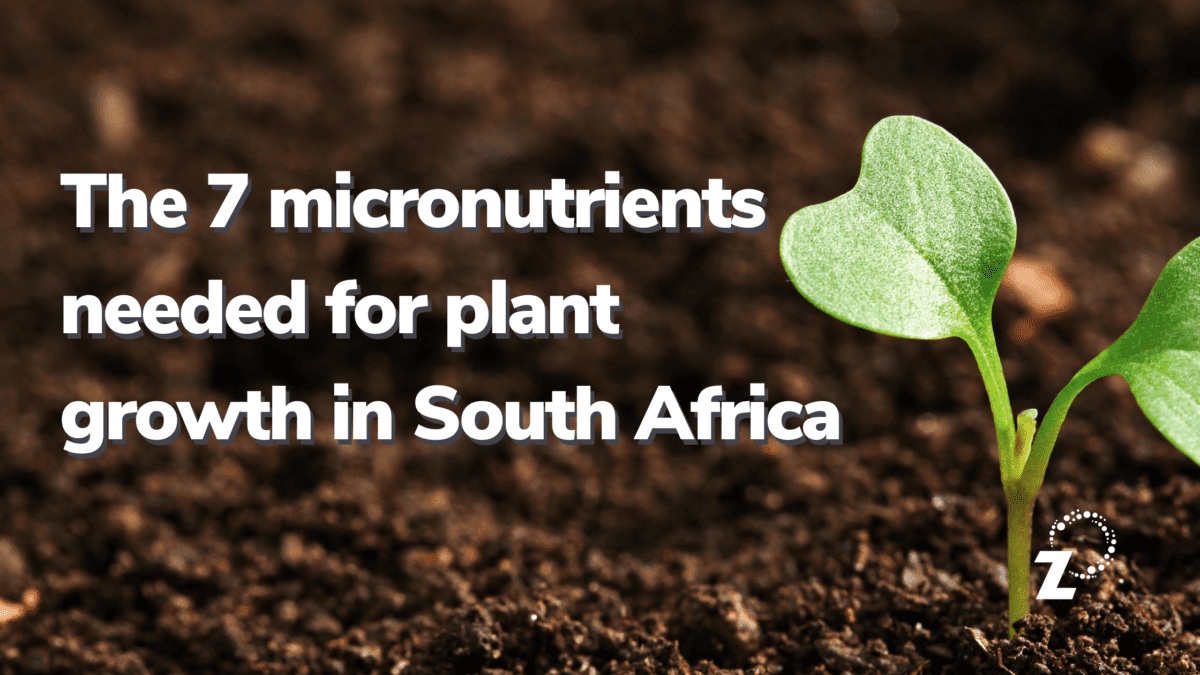As a grower or farmer, you may constantly be dosing your system with extra nutrients in the hopes that your plants will thrive. But each nutrient has a specific role to play, and you need to understand how the seven micronutrients work to optimise crop production, promote sustainable agriculture, and achieve economic benefits.
What are micronutrients?
Nutrients can be macronutrients and micronutrients; the only difference between these two is the amounts required for plant survival:
- Macronutrients are required in large amounts
- Micronutrients are required in smaller quantities
Although only found in trace amounts in plant tissue, micronutrients play an imperative role in plant growth and development. A deficiency of any of these nutrients can lead to potential declines in productivity.
Why care about micronutrients in South Africa?
In South Africa, soil conditions can vary widely depending on the region and climate. Some regions may have soils that are naturally deficient in one or more micronutrients, while other regions may have excesses of certain micronutrients due to over-fertilisation or other factors. Factors such as soil erosion, long-term cropping, and the replacement of micronutrient-rich manures with mineral fertilisers have led to an increasing need for micronutrient fertilisation in South African farming. Collectively, these factors have led farmers to question whether micronutrient fertilisation may now be required to meet the changing demands of crop nutrition.
But both deficiency and over-fertilisation with micronutrients can also be a problem in South Africa, particularly in areas where farmers may be using excessive amounts of fertilisers in an attempt to improve crop yields. This can lead to nutrient imbalances in the soil, as well as environmental problems such as water pollution and reduced soil fertility over time.
Here are some reasons why it is important for farmers to understand how micronutrients work:
- Optimal Plant Growth: Understanding the roles of micronutrients and their interactions is critical in achieving optimal plant growth and yield. Plants require a balanced supply of micronutrients throughout their growth stages to produce healthy, high-quality crops.
- Nutrient Management: Farmers need to manage their nutrient inputs effectively to ensure that their crops receive adequate amounts of each. By understanding the roles of micronutrients and how they affect plant growth, farmers can apply fertilisers more efficiently and prevent nutrient deficiencies or toxicities.
- Sustainable Agriculture: Sustainable agriculture practices involve optimising crop productivity while minimising environmental impact. Proper nutrient management is essential to achieve this goal. By understanding the roles of micronutrients, farmers can implement nutrient management strategies that promote soil health and fertility, reduce nutrient losses, and enhance crop yields.
- Economic Benefits: Understanding how micronutrients work can lead to increased profits and long-term economic benefits for farmers through improved yield and productivity.
What are the 7 main micronutrients required for plant growth?
Of the elements essential for plant growth, the seven main micronutrients are:
- Boron (B)
- Chlorine (CI)
- Copper (Cu)
- Iron (Fe)
- Manganese (Mn)
- Molybdenum (Mo)
- Zinc (Zn)
They play a crucial role in plant nutrition, and their absence can lead to a decline in plant productivity.
Micronutrient roles in plant nutrition
| Micronutrient | Functions | Signs of deficiencies |
| Boron | Contributes to the structural integrity of the cell wall Balances the amounts of sugar and starch in a plant Required for pollen germination, membrane function, cell differentiation Involved in carbohydrate translocation, nucleic acid synthesis, hormone metabolism and fat metabolism | Block necrosis of young leaves and terminal buds Stem becomes stiff and brittle Stem becomes highly branched due to loss of apical dominance Necrosis of root, fruits and tubers Abscission of flowers Absence of root nodules in leguminous plants Internal tissues become corky |
| Iron | Micronutrient required by plants in the largest amounts An important electron carrier Crucial for the production of chlorophyll for photosynthesis | Chlorosis of younger leaves Veins become chlorotic The whole leaf gradually becomes whiteInhibits chloroplast formation |
| Copper | Assists in carrying out reactions that occur in photosynthesis and respiration Associated with enzymes involved in redox reactions | Production of dark green leaves which may contain necrotic spots Leaves become malformed Leaves fall prematurely Dieback of shoot in fruit trees Exanthema disease in tree when bark exudes gum Blackening of potatoes |
| Zinc | Activates enzymes involved in the production of growth hormones Takes part in the synthesis of auxin precursor | Leaf distortion or disorders Reduction in fruits Stunted growth |
| Manganese | Plays a critical role in photosynthesis as it is used to free oxygen Activates many enzymes of TCA cycle Nitrogen metabolism | Chlorosis associated with necrotic spots develop in leaves Chloroplast become vacuolated and granular |
| Molybdenum | Potassium absorption Assists in the nitrogen cycle within a plant | Slight retardation of growth Whiptail disease in cabbage Yellow spot disease of citrus Premature fall of flowers |
| Chlorine | Plays a role in the oxygen-evolving reactions of photosynthesis Assists in the operation of the stomata for gas regulation Required for cell division in both leaves and roots | Wilting of leaf tips Leaf chlorosis and necrosis Stunted root growth Reduced fruiting |
As you can see from above, each nutrient has a specific role to carry out in plant nutrition. Understanding the specific roles and requirements of each micronutrient is crucial for farmers to manage and maintain the full spectrum of nutrients required for plant growth in South Africa. You can also check out our common plant nutrient deficiency table to see how you can spot and treat your micronutrient problems in a safe, natural way.
Products to manage micronutrients
Zylem’s biological soil amendments, nutrition, and foliar feeds can be used to address micronutrient imbalances. For example, Zylem’s Micros Z is a liquid fertiliser used to treat zinc and manganese deficiency in plants. Nutri-Key Shuttle SevenTM contains high concentrations of the seven micronutrients needed for plants to thrive in the South African climate. Get in touch to learn more about the right micronutrient applications for your specific needs.

About the Author: Alex Platt
Alex is Business Development Manager at Zylem. He’s inspired by the potential of regenerative farming and takes a special interest in the technology and products that are moving agriculture in a more sustainable direction.

